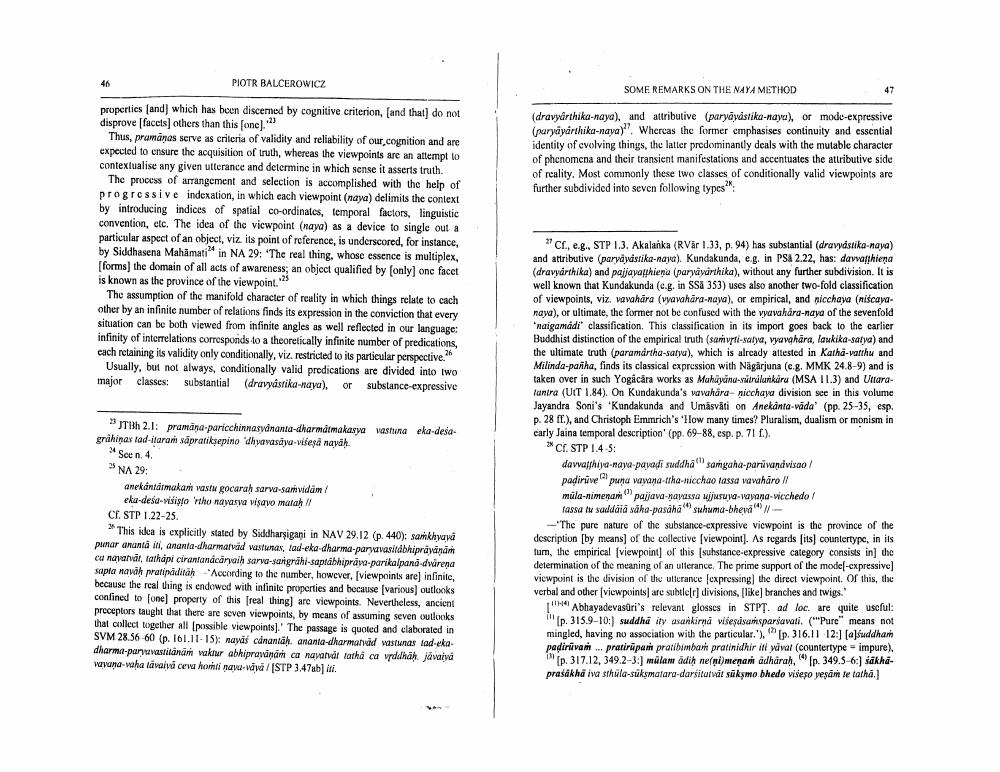Book Title: Some Remarks On The Naya Mmethod Author(s): Piotr Balcerowicz Publisher: Piotr Balcerowicz View full book textPage 6
________________ PIOTR BALCEROWICZ SOME REMARKS ON THE NAYA METHOD (dravarthika-naya), and attributive (paryavastika-rayu)or mode expressive (urydyarthika-naya)". Whereas the former emphasises continuity and essential identity of evolving things, the latter predominantly deals with the mutable character of phenomena and their transient manifestations and accentuates the attributive side of reality. Most commonly these two classes of conditionally valid viewpoints are further subdivided into seven following types: properties (and) which has been discerned by cognitive criterion, and that) do not disprove (facets) others than this conc).23 Thus, pramanas serve as criteria of validity and reliability of our cognition and are expected to ensure the acquisition of truth, whereas the viewpoints are an attempt to contextualise any given utterance and determine in which sense it asserts truth. The process of arrangement and selection is accomplished with the help of progressive indexation, in which cach viewpoint (naya) delimits the context by introducing indices of spatial co-ordinates, temporal factors, linguistic convention, etc. The idea of the viewpoint (naya) as a device to single out a particular aspect of an object, viz its point of reference, is underscored, for instance, by Siddhasena Mahamati in NA 29: 'The real thing, whose essence is multiplex, [forms) the domain of all acts of awareness, an object qualified by (only) onc facet is known as the province of the viewpoint.12 The assumption of the manifold character of reality in which things relate to cach other by an infinite number of relations finds its expression in the conviction that every situation can be both viewed from infinite angles as well reflected in our language: infinity of interrelations corresponds to a theoretically infinite number of predications, each retaining its validity only conditionally, viz. restricted to its particular perspective.** Usually, but not always, conditionally valid predications are divided into two major classes: substantial (dravyasrika-naya) or substance-expressive JT13h 2.1: pramasaparicchinnasvananta-dharmatmakarya vastuna eka-desa gråhinas tad-itaram sāpratiksepino 'dhyavasayu više nayah Soen. 4. NA 29: anekantamakam vastu gocarah sarva-santvidam! eka-des-visisorto navasya visavo matah CF. STP 1.22-25. *This idea is explicitly stated by Siddharşigani in NAV 29.12 (p. 440): samkhyuva punar ananta ill, ananta-dharmavad vastunas, tad-eka-dharma paryawasildbhiprayanam ca navadi, fathapi cirantandcdraih sarva-sangrahi-saptábhiprava par kalpana-dvarena sapta mavi pratipiditah According to the number, however, [viewpoints are infinite, because the real thing is endowed with infinite properties and because (various outlooks confined to fone) property of this (real thing) are viewpoints. Nevertheless, ancient preceptors taught that there are seven viewpoints, by means of assuming seven outlooks that collect together all possible viewpoints). The passage is quoted and claborated in SVM 28.56 60 (p. 161.1115): navas cananiah, ananta-dharma wasturas tadeka dharma.paruvastitanam vaktur abhipravandin ca navahvat tatha ca voluhan javaiya vayund-vahavaiva ceva hom nayu-aya/ [STP 3.47ab] iti. CLR, STP 1.3. Akalanka (RVár 1.33. p. 94) has substantial (dravydstikanava) and attributive (paryddstika-naya). Kundakunda, eg. in PSA 2.22, has: davanthiena (dravdrthika) and paijayashion (paryavarthika), without any further subdivision. It is well known that Kundakunda (e.g. in SSI 353) uses also another two-fold classification of viewpoints, viz. vavahara (vyavahara-nava), or empirical, and nicchawa (niscaya nawa), or ultimate, the former not be confused with the wavahara-naya of the sevenfold naigamddi" classification. This classification in its import goes back to the earlier Buddhist distinction of the empirical truth (santvrti-satya, vyuvghara, laukika-satya) and the ultimate truth (paramdrtha-sayu), which is already attested in Katha-yath and Milinda patiha, finds its classical expression with Nagarjuna (c.g. MMK 24.8-9) and is taken over in such Yogacára works as Mahüyüna-vurulunkuru (MSA 11.3) and Ullaralantra (UiT 1.84), On Kundakunda's wawahara- nicchaya division see in this volume Jayandra Soni's 'Kundakunda and Umásváti on Anekanta-vada' (pp. 25-35, esp. p.28 II.), and Christoph Emmrich's 'How many times? Pluralism, dualism or monism in carly Jaina temporal description" (pp. 69-88, esp. p. 71 f.). *CI. STP 1.4 5: davarthiyanawa.pavodi suddhasargaha-pariwandwisao/ padirūve puna vavana-tha-nicchao lassa vavahāro II mula-nimenampaijawa-nayassa jutuva-vayana wicchedo! fassa tu saddaia saho-pasäha suhuma-bheva"-"The pure nature of the substance-expressive viewpoint is the province of the description [by means of the collective viewpoint). As regards (its countertype, in its turn, the empirical viewpoint of this substance expressive category consists in the determination of the meaning of an utterance. The prime support of the model expressive viewpoint is the division of the utterance expressing) the direct viewpoint. Or this, the verbal and other viewpoints are subtle[t] divisions (like branches and twigs. " Abhayadevasri's relevant glosses in STPT. ad loc. are quite useful: p. 315.9-10:) suddha ilyasarkirna visessarsparsawati (""Pure" means not mingled, having no association with the particular.'), p. 316.11 12:1 (Juddha padiruvann.. pratirupathi pratibimba pratinidhir il vival (countertype impure), [p. 317.12, 349.2-3:] mulam adit nelaimenant adharah,"Ip. 349.5-6:) sakhaprasakhi ivasthula-suksmataro-darsitavat sūksmo bhede viseso yesante tatha.Page Navigation
1 ... 4 5 6 7 8 9 10 11 12 13 14 15 16 17
